BM565 Digital Business: Transforming Customer Experience with New Tech
VerifiedAdded on 2023/06/12
|11
|2650
|373
Report
AI Summary
This report examines the significance of digital technologies in transforming customer experience within businesses. It discusses the development of these technologies, their applications, and the platforms and software involved. The report covers the relationship between digital technologies and customer experience, highlighting how businesses use these tools to enhance customer engagement and loyalty. Various management theories, including system management, contingency theory, and decision-making theory, are explored in the context of digital transformation. Additionally, different e-commerce models, such as B2C, C2B, B2B, and C2C, are discussed, illustrating how businesses leverage these models to conduct online activities and improve customer interactions. The report concludes by emphasizing the vital role of digital technologies in modern business organizations and the advantages they offer in terms of customer base expansion and profitability.

Digital Business &
New Technologies
New Technologies
Paraphrase This Document
Need a fresh take? Get an instant paraphrase of this document with our AI Paraphraser
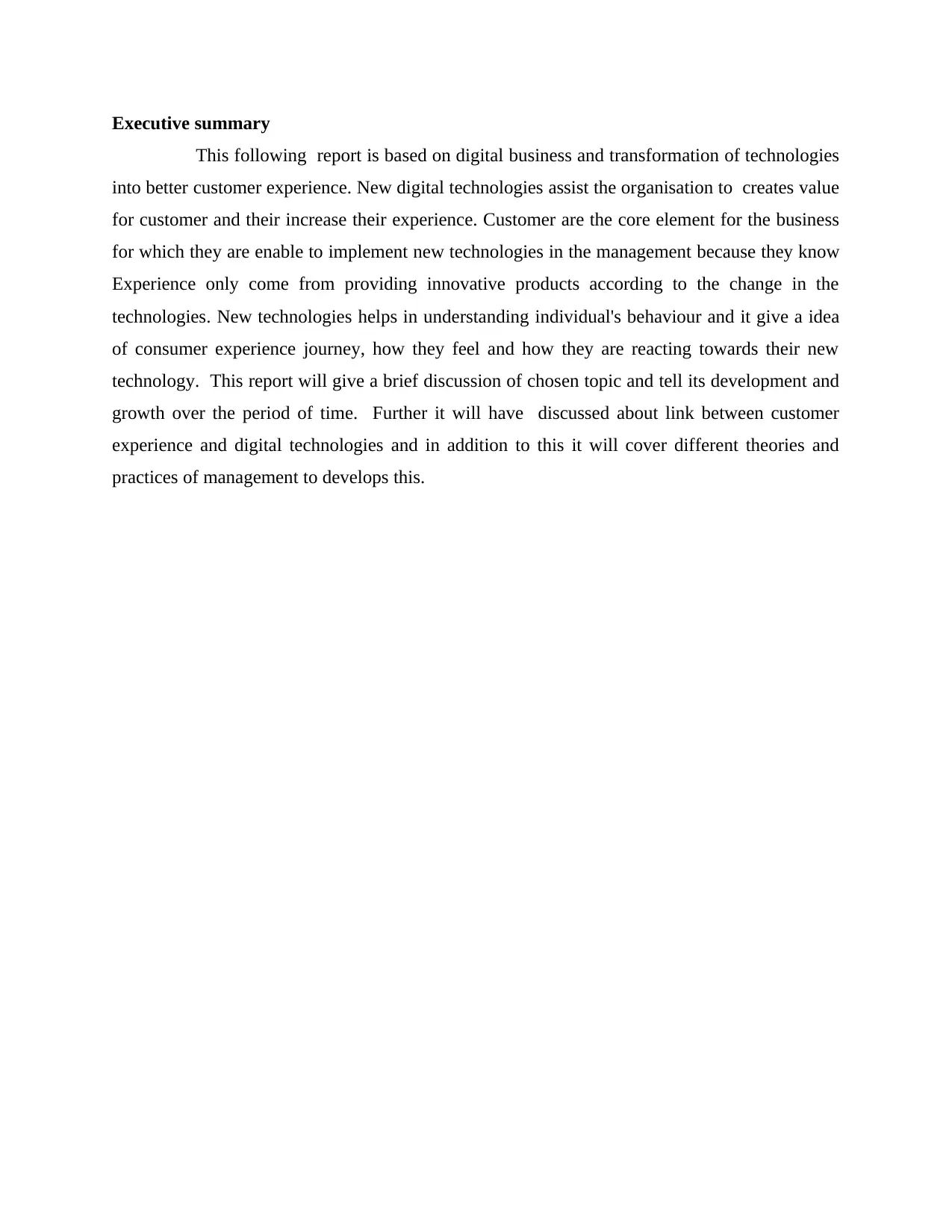
Executive summary
This following report is based on digital business and transformation of technologies
into better customer experience. New digital technologies assist the organisation to creates value
for customer and their increase their experience. Customer are the core element for the business
for which they are enable to implement new technologies in the management because they know
Experience only come from providing innovative products according to the change in the
technologies. New technologies helps in understanding individual's behaviour and it give a idea
of consumer experience journey, how they feel and how they are reacting towards their new
technology. This report will give a brief discussion of chosen topic and tell its development and
growth over the period of time. Further it will have discussed about link between customer
experience and digital technologies and in addition to this it will cover different theories and
practices of management to develops this.
This following report is based on digital business and transformation of technologies
into better customer experience. New digital technologies assist the organisation to creates value
for customer and their increase their experience. Customer are the core element for the business
for which they are enable to implement new technologies in the management because they know
Experience only come from providing innovative products according to the change in the
technologies. New technologies helps in understanding individual's behaviour and it give a idea
of consumer experience journey, how they feel and how they are reacting towards their new
technology. This report will give a brief discussion of chosen topic and tell its development and
growth over the period of time. Further it will have discussed about link between customer
experience and digital technologies and in addition to this it will cover different theories and
practices of management to develops this.
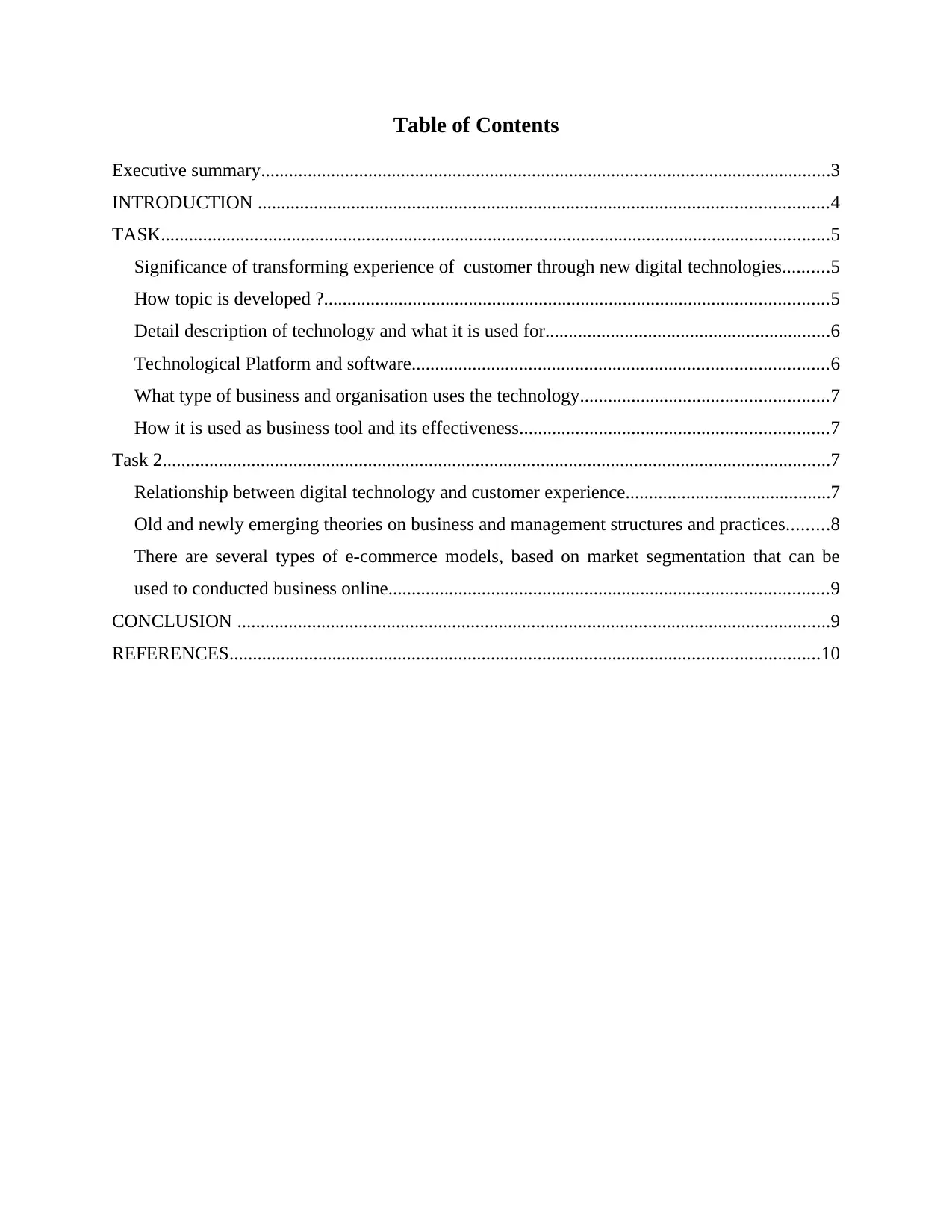
Table of Contents
Executive summary..........................................................................................................................3
INTRODUCTION ..........................................................................................................................4
TASK...............................................................................................................................................5
Significance of transforming experience of customer through new digital technologies..........5
How topic is developed ?............................................................................................................5
Detail description of technology and what it is used for.............................................................6
Technological Platform and software.........................................................................................6
What type of business and organisation uses the technology.....................................................7
How it is used as business tool and its effectiveness..................................................................7
Task 2...............................................................................................................................................7
Relationship between digital technology and customer experience............................................7
Old and newly emerging theories on business and management structures and practices.........8
There are several types of e-commerce models, based on market segmentation that can be
used to conducted business online..............................................................................................9
CONCLUSION ...............................................................................................................................9
REFERENCES..............................................................................................................................10
Executive summary..........................................................................................................................3
INTRODUCTION ..........................................................................................................................4
TASK...............................................................................................................................................5
Significance of transforming experience of customer through new digital technologies..........5
How topic is developed ?............................................................................................................5
Detail description of technology and what it is used for.............................................................6
Technological Platform and software.........................................................................................6
What type of business and organisation uses the technology.....................................................7
How it is used as business tool and its effectiveness..................................................................7
Task 2...............................................................................................................................................7
Relationship between digital technology and customer experience............................................7
Old and newly emerging theories on business and management structures and practices.........8
There are several types of e-commerce models, based on market segmentation that can be
used to conducted business online..............................................................................................9
CONCLUSION ...............................................................................................................................9
REFERENCES..............................................................................................................................10
⊘ This is a preview!⊘
Do you want full access?
Subscribe today to unlock all pages.

Trusted by 1+ million students worldwide
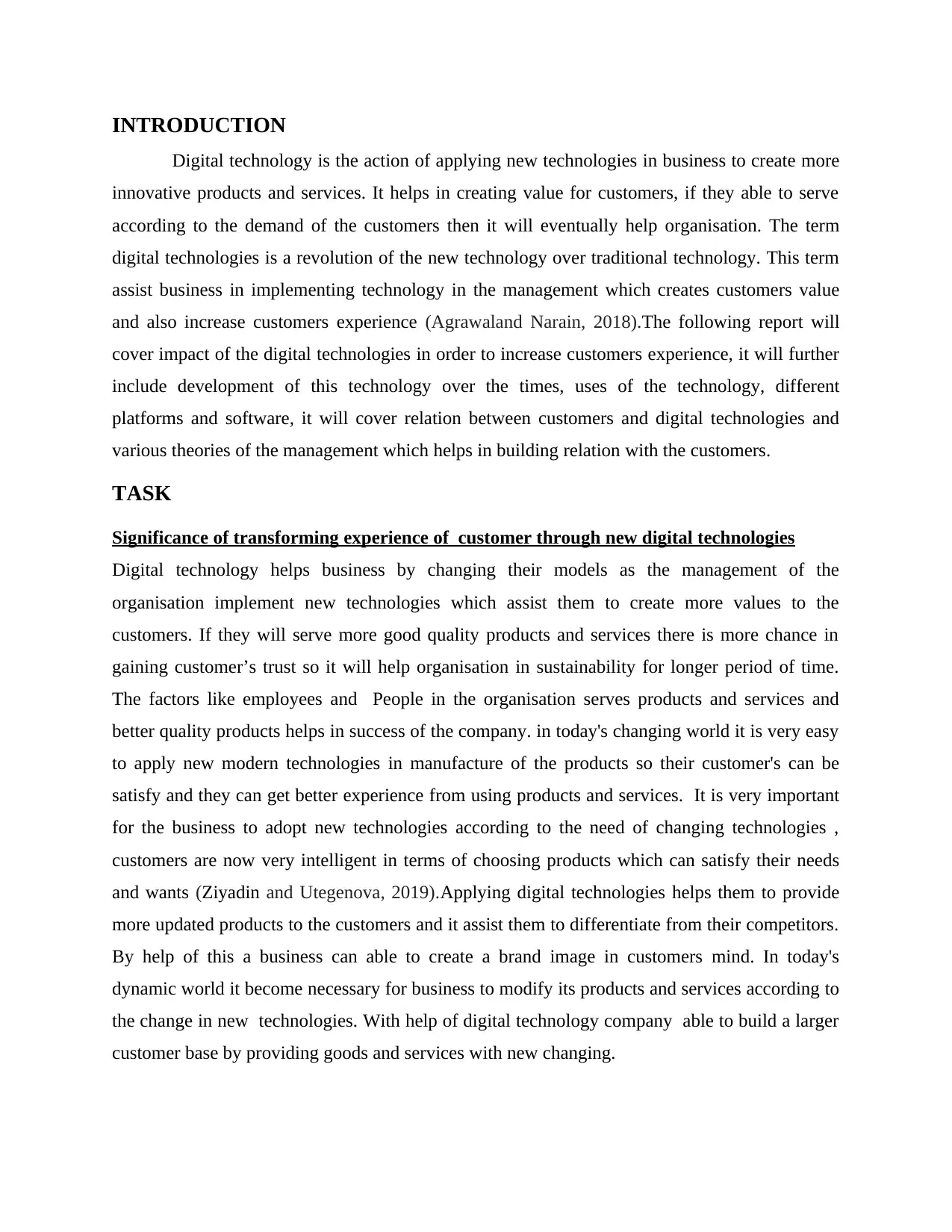
INTRODUCTION
Digital technology is the action of applying new technologies in business to create more
innovative products and services. It helps in creating value for customers, if they able to serve
according to the demand of the customers then it will eventually help organisation. The term
digital technologies is a revolution of the new technology over traditional technology. This term
assist business in implementing technology in the management which creates customers value
and also increase customers experience (Agrawaland Narain, 2018).The following report will
cover impact of the digital technologies in order to increase customers experience, it will further
include development of this technology over the times, uses of the technology, different
platforms and software, it will cover relation between customers and digital technologies and
various theories of the management which helps in building relation with the customers.
TASK
Significance of transforming experience of customer through new digital technologies
Digital technology helps business by changing their models as the management of the
organisation implement new technologies which assist them to create more values to the
customers. If they will serve more good quality products and services there is more chance in
gaining customer’s trust so it will help organisation in sustainability for longer period of time.
The factors like employees and People in the organisation serves products and services and
better quality products helps in success of the company. in today's changing world it is very easy
to apply new modern technologies in manufacture of the products so their customer's can be
satisfy and they can get better experience from using products and services. It is very important
for the business to adopt new technologies according to the need of changing technologies ,
customers are now very intelligent in terms of choosing products which can satisfy their needs
and wants (Ziyadin and Utegenova, 2019).Applying digital technologies helps them to provide
more updated products to the customers and it assist them to differentiate from their competitors.
By help of this a business can able to create a brand image in customers mind. In today's
dynamic world it become necessary for business to modify its products and services according to
the change in new technologies. With help of digital technology company able to build a larger
customer base by providing goods and services with new changing.
Digital technology is the action of applying new technologies in business to create more
innovative products and services. It helps in creating value for customers, if they able to serve
according to the demand of the customers then it will eventually help organisation. The term
digital technologies is a revolution of the new technology over traditional technology. This term
assist business in implementing technology in the management which creates customers value
and also increase customers experience (Agrawaland Narain, 2018).The following report will
cover impact of the digital technologies in order to increase customers experience, it will further
include development of this technology over the times, uses of the technology, different
platforms and software, it will cover relation between customers and digital technologies and
various theories of the management which helps in building relation with the customers.
TASK
Significance of transforming experience of customer through new digital technologies
Digital technology helps business by changing their models as the management of the
organisation implement new technologies which assist them to create more values to the
customers. If they will serve more good quality products and services there is more chance in
gaining customer’s trust so it will help organisation in sustainability for longer period of time.
The factors like employees and People in the organisation serves products and services and
better quality products helps in success of the company. in today's changing world it is very easy
to apply new modern technologies in manufacture of the products so their customer's can be
satisfy and they can get better experience from using products and services. It is very important
for the business to adopt new technologies according to the need of changing technologies ,
customers are now very intelligent in terms of choosing products which can satisfy their needs
and wants (Ziyadin and Utegenova, 2019).Applying digital technologies helps them to provide
more updated products to the customers and it assist them to differentiate from their competitors.
By help of this a business can able to create a brand image in customers mind. In today's
dynamic world it become necessary for business to modify its products and services according to
the change in new technologies. With help of digital technology company able to build a larger
customer base by providing goods and services with new changing.
Paraphrase This Document
Need a fresh take? Get an instant paraphrase of this document with our AI Paraphraser
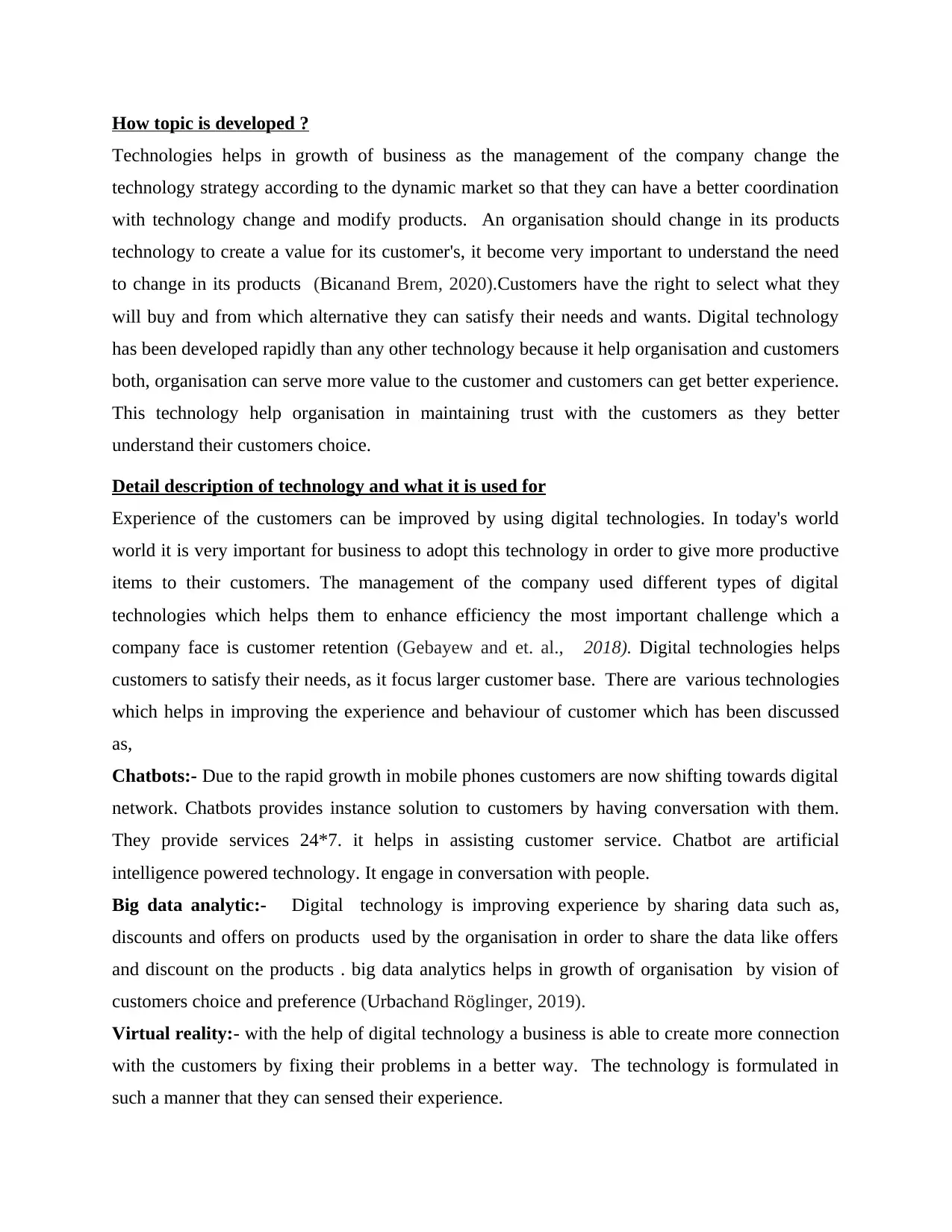
How topic is developed ?
Technologies helps in growth of business as the management of the company change the
technology strategy according to the dynamic market so that they can have a better coordination
with technology change and modify products. An organisation should change in its products
technology to create a value for its customer's, it become very important to understand the need
to change in its products (Bicanand Brem, 2020).Customers have the right to select what they
will buy and from which alternative they can satisfy their needs and wants. Digital technology
has been developed rapidly than any other technology because it help organisation and customers
both, organisation can serve more value to the customer and customers can get better experience.
This technology help organisation in maintaining trust with the customers as they better
understand their customers choice.
Detail description of technology and what it is used for
Experience of the customers can be improved by using digital technologies. In today's world
world it is very important for business to adopt this technology in order to give more productive
items to their customers. The management of the company used different types of digital
technologies which helps them to enhance efficiency the most important challenge which a
company face is customer retention (Gebayew and et. al., 2018). Digital technologies helps
customers to satisfy their needs, as it focus larger customer base. There are various technologies
which helps in improving the experience and behaviour of customer which has been discussed
as,
Chatbots:- Due to the rapid growth in mobile phones customers are now shifting towards digital
network. Chatbots provides instance solution to customers by having conversation with them.
They provide services 24*7. it helps in assisting customer service. Chatbot are artificial
intelligence powered technology. It engage in conversation with people.
Big data analytic:- Digital technology is improving experience by sharing data such as,
discounts and offers on products used by the organisation in order to share the data like offers
and discount on the products . big data analytics helps in growth of organisation by vision of
customers choice and preference (Urbachand Röglinger, 2019).
Virtual reality:- with the help of digital technology a business is able to create more connection
with the customers by fixing their problems in a better way. The technology is formulated in
such a manner that they can sensed their experience.
Technologies helps in growth of business as the management of the company change the
technology strategy according to the dynamic market so that they can have a better coordination
with technology change and modify products. An organisation should change in its products
technology to create a value for its customer's, it become very important to understand the need
to change in its products (Bicanand Brem, 2020).Customers have the right to select what they
will buy and from which alternative they can satisfy their needs and wants. Digital technology
has been developed rapidly than any other technology because it help organisation and customers
both, organisation can serve more value to the customer and customers can get better experience.
This technology help organisation in maintaining trust with the customers as they better
understand their customers choice.
Detail description of technology and what it is used for
Experience of the customers can be improved by using digital technologies. In today's world
world it is very important for business to adopt this technology in order to give more productive
items to their customers. The management of the company used different types of digital
technologies which helps them to enhance efficiency the most important challenge which a
company face is customer retention (Gebayew and et. al., 2018). Digital technologies helps
customers to satisfy their needs, as it focus larger customer base. There are various technologies
which helps in improving the experience and behaviour of customer which has been discussed
as,
Chatbots:- Due to the rapid growth in mobile phones customers are now shifting towards digital
network. Chatbots provides instance solution to customers by having conversation with them.
They provide services 24*7. it helps in assisting customer service. Chatbot are artificial
intelligence powered technology. It engage in conversation with people.
Big data analytic:- Digital technology is improving experience by sharing data such as,
discounts and offers on products used by the organisation in order to share the data like offers
and discount on the products . big data analytics helps in growth of organisation by vision of
customers choice and preference (Urbachand Röglinger, 2019).
Virtual reality:- with the help of digital technology a business is able to create more connection
with the customers by fixing their problems in a better way. The technology is formulated in
such a manner that they can sensed their experience.

Technological Platform and software
To handle experience of the customers the company used new and advanced digital
technologies in a better way. Technologies like vision driven and data management analytics
are used of the management of the company to enhance customer care service. For enhancing
customer experience company use different types of platforms some are, email, website, calling
etc. by using this company able to interact well with the customer.
What type of business and organisation uses the technology
Digital technologies are very helpful for organisation all across the world. They relies on
this because this technology assist them to move forward their business activities in very
effective and efficient manner. The motive of implementing digital technology is to enhance
customers base and their loyalty for your business eventually for increasing profits. New
technologies attracts more and more customers. It is used by all type of company whether it is
small company, medium company or large company for providing better services in order to
retention of the existing customers. Some of the examples are virtual reality technology is used
by TESCO plc in transforming the customer experience. Artificial intelligence which works
with IBM is used by the Hilton hotels.
How it is used as business tool and its effectiveness
Digital technology used as a business tool for company as it helps them to give best
services to customers (Hanelt and et. al., 2021).They can go through official website and search
for products they want to buy and can also choose fast delivery option, it assist organisation to
cover most of the geographical area. this technologies is also used to in track as well as measure
the footmark of the customers online, it helps organisation to provide services according to the
customers demand. The traditional technologies like typewriter is replaced by the computer
with advanced software and mobile phones take the place of telephones which help in share
thoughts and resources in a effective manner.
Task 2
Relationship between digital technology and customer experience
customer experience plays an essential role in transforming digital technology and also in
improving customer experience. It leads to fill gap between services provide and customer
expectation. According to the research it has been concluded that, if a company receives positive
To handle experience of the customers the company used new and advanced digital
technologies in a better way. Technologies like vision driven and data management analytics
are used of the management of the company to enhance customer care service. For enhancing
customer experience company use different types of platforms some are, email, website, calling
etc. by using this company able to interact well with the customer.
What type of business and organisation uses the technology
Digital technologies are very helpful for organisation all across the world. They relies on
this because this technology assist them to move forward their business activities in very
effective and efficient manner. The motive of implementing digital technology is to enhance
customers base and their loyalty for your business eventually for increasing profits. New
technologies attracts more and more customers. It is used by all type of company whether it is
small company, medium company or large company for providing better services in order to
retention of the existing customers. Some of the examples are virtual reality technology is used
by TESCO plc in transforming the customer experience. Artificial intelligence which works
with IBM is used by the Hilton hotels.
How it is used as business tool and its effectiveness
Digital technology used as a business tool for company as it helps them to give best
services to customers (Hanelt and et. al., 2021).They can go through official website and search
for products they want to buy and can also choose fast delivery option, it assist organisation to
cover most of the geographical area. this technologies is also used to in track as well as measure
the footmark of the customers online, it helps organisation to provide services according to the
customers demand. The traditional technologies like typewriter is replaced by the computer
with advanced software and mobile phones take the place of telephones which help in share
thoughts and resources in a effective manner.
Task 2
Relationship between digital technology and customer experience
customer experience plays an essential role in transforming digital technology and also in
improving customer experience. It leads to fill gap between services provide and customer
expectation. According to the research it has been concluded that, if a company receives positive
⊘ This is a preview!⊘
Do you want full access?
Subscribe today to unlock all pages.

Trusted by 1+ million students worldwide

response from customers by digital transformation it leads to success of the organisation. Here it
includes examples of company like, Amazon, it is a huge customer base e commerce company
which enjoying advantage from digital technologies and it helps them to connects with larger
customer base. Organisation take feedbacks from their customers so that they can enhance their
product quality and services. Experience of the customers have evolved with using digital
technology. New technology like, personal selling, email, calling, and many more helps
organisation to expand its business across boundaries (Tekic and Koroteev, 2019)
Old and newly emerging theories on business and management structures and practices
Business is a very broad term and consider old as well as new theories of management. These
theories can be used by the managers of the management in improve their working system and
productiveness. There are various theories which is applied by the firm in order to work effective
and efficient. The different types of management theories has been mentioned below: -
System management theory:- The theory is utilized by the firm in managing and
planning as an alternative approach, it is viewed as foundation of organisational growth.
success of the company is depend on interrelation between subsystems in the
organisation. In organisation not only the employees but also the departments are also
very important.
Contingency theory- this theory is based on the leadership which is related to the
attribute. The leaders of the company should be flexible in nature so that they can adapt
new modification in the organisation. Applying effective theories according to the needs
is very important for the management of the firm. At every level of the organisation
technology must be used and management have to focus on the leadership style which
assist in identifying the structure of the company (Senyo, Liuand Effah, 2019).
Decision making theory- the theory provides an realistic aspect to the business that the
decision are totally impressed by the outputs and value. Decisions are formed by the
system in different phases as the first stage in management is recognised the problems
then search the information. and then select the best fit. The decision making theory
helps the organisation in understanding the behaviour of the consumer and also in
influencing the choice of the customer (Kane and et. al., 2019). Different set of
expression has been used in this theory in relation to the rational behaviour of the
consumer as this is being considered as a challenge on empirical and theoretical ground.
includes examples of company like, Amazon, it is a huge customer base e commerce company
which enjoying advantage from digital technologies and it helps them to connects with larger
customer base. Organisation take feedbacks from their customers so that they can enhance their
product quality and services. Experience of the customers have evolved with using digital
technology. New technology like, personal selling, email, calling, and many more helps
organisation to expand its business across boundaries (Tekic and Koroteev, 2019)
Old and newly emerging theories on business and management structures and practices
Business is a very broad term and consider old as well as new theories of management. These
theories can be used by the managers of the management in improve their working system and
productiveness. There are various theories which is applied by the firm in order to work effective
and efficient. The different types of management theories has been mentioned below: -
System management theory:- The theory is utilized by the firm in managing and
planning as an alternative approach, it is viewed as foundation of organisational growth.
success of the company is depend on interrelation between subsystems in the
organisation. In organisation not only the employees but also the departments are also
very important.
Contingency theory- this theory is based on the leadership which is related to the
attribute. The leaders of the company should be flexible in nature so that they can adapt
new modification in the organisation. Applying effective theories according to the needs
is very important for the management of the firm. At every level of the organisation
technology must be used and management have to focus on the leadership style which
assist in identifying the structure of the company (Senyo, Liuand Effah, 2019).
Decision making theory- the theory provides an realistic aspect to the business that the
decision are totally impressed by the outputs and value. Decisions are formed by the
system in different phases as the first stage in management is recognised the problems
then search the information. and then select the best fit. The decision making theory
helps the organisation in understanding the behaviour of the consumer and also in
influencing the choice of the customer (Kane and et. al., 2019). Different set of
expression has been used in this theory in relation to the rational behaviour of the
consumer as this is being considered as a challenge on empirical and theoretical ground.
Paraphrase This Document
Need a fresh take? Get an instant paraphrase of this document with our AI Paraphraser

There are several types of e-commerce models, based on market segmentation that can be
used to conducted business online
Business-to-Consumer (B2C):- This term is refers as selling of goods and services
directly to the consumers who are the end users of product and services. Most of the
companies sells their products in B2C method.
Consumer-to-Business (C2B):- It is a e commerce activity where a consumer sells
products or services to the business . Examples of C2B are, referrals games, data sharing
and paid testimonials etc.
Business-to-Business (B2B):- this term refers as direct selling activity between
consumers and organisation. The companies who engage in B2B activity mainly called
(Nwaiwu, 2018).
Consumer-to-Consumer (C2C):- this e-commerce activity helps the consumers in
selling their products and services to other consumer through online platforms. This
model is growing very faster. In this there is direct connection between consumer to
consumer.
CONCLUSION
In this following report this has been concluded that there is a vital role of digital technologies in
business organisation. There are many advantages of this technology which helps organisation
implementing new strategy which assist in better performance. With evolvement of the
technology helps in providing better services and products to the customer’s. Some of the types
of digital technologies are, artificial technological, chatbots, robotic process automation, block
chain, virtual reality, big data analysts etc. further it has been concluded various theories of the
management which assist them to understand their consumers in a very effective manner.
used to conducted business online
Business-to-Consumer (B2C):- This term is refers as selling of goods and services
directly to the consumers who are the end users of product and services. Most of the
companies sells their products in B2C method.
Consumer-to-Business (C2B):- It is a e commerce activity where a consumer sells
products or services to the business . Examples of C2B are, referrals games, data sharing
and paid testimonials etc.
Business-to-Business (B2B):- this term refers as direct selling activity between
consumers and organisation. The companies who engage in B2B activity mainly called
(Nwaiwu, 2018).
Consumer-to-Consumer (C2C):- this e-commerce activity helps the consumers in
selling their products and services to other consumer through online platforms. This
model is growing very faster. In this there is direct connection between consumer to
consumer.
CONCLUSION
In this following report this has been concluded that there is a vital role of digital technologies in
business organisation. There are many advantages of this technology which helps organisation
implementing new strategy which assist in better performance. With evolvement of the
technology helps in providing better services and products to the customer’s. Some of the types
of digital technologies are, artificial technological, chatbots, robotic process automation, block
chain, virtual reality, big data analysts etc. further it has been concluded various theories of the
management which assist them to understand their consumers in a very effective manner.
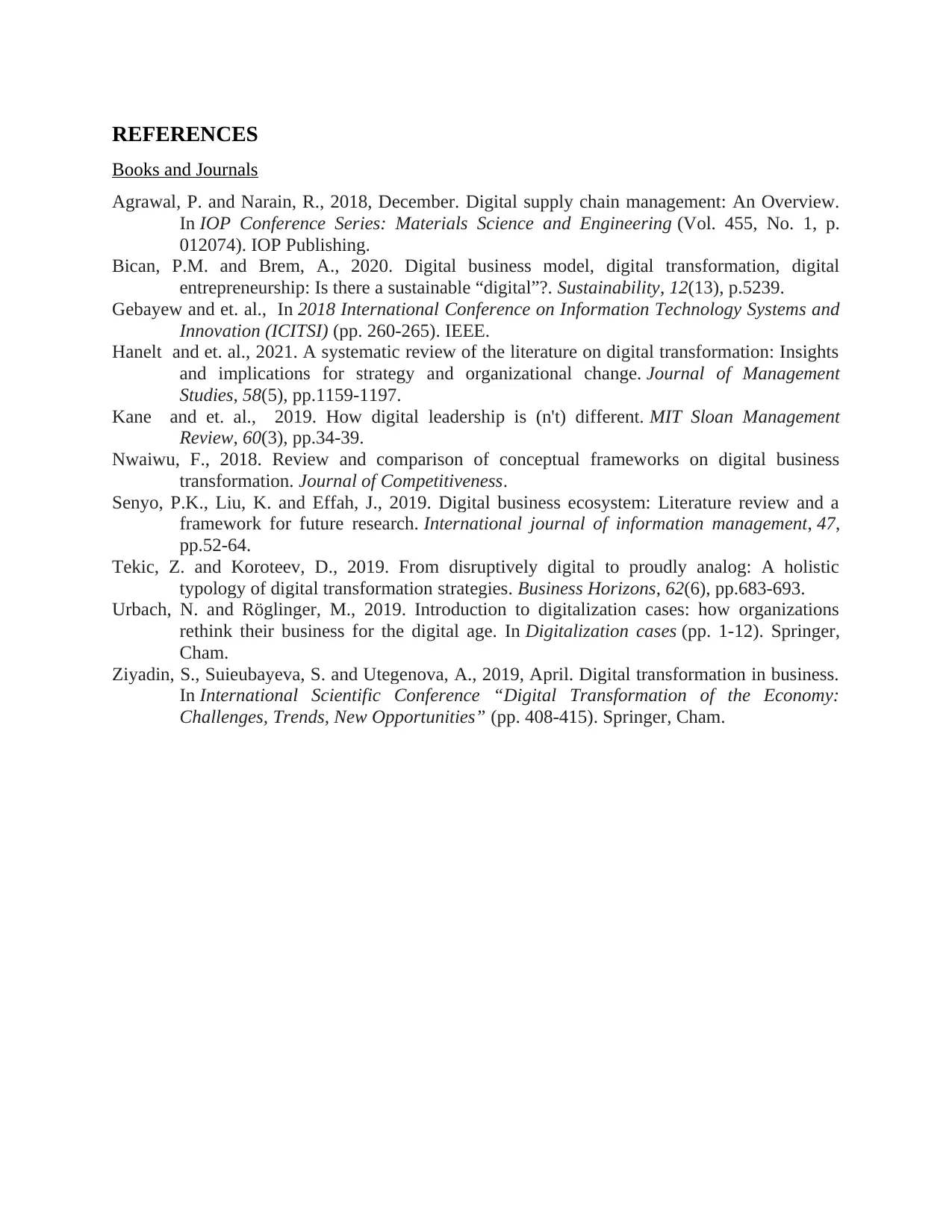
REFERENCES
Books and Journals
Agrawal, P. and Narain, R., 2018, December. Digital supply chain management: An Overview.
In IOP Conference Series: Materials Science and Engineering (Vol. 455, No. 1, p.
012074). IOP Publishing.
Bican, P.M. and Brem, A., 2020. Digital business model, digital transformation, digital
entrepreneurship: Is there a sustainable “digital”?. Sustainability, 12(13), p.5239.
Gebayew and et. al., In 2018 International Conference on Information Technology Systems and
Innovation (ICITSI) (pp. 260-265). IEEE.
Hanelt and et. al., 2021. A systematic review of the literature on digital transformation: Insights
and implications for strategy and organizational change. Journal of Management
Studies, 58(5), pp.1159-1197.
Kane and et. al., 2019. How digital leadership is (n't) different. MIT Sloan Management
Review, 60(3), pp.34-39.
Nwaiwu, F., 2018. Review and comparison of conceptual frameworks on digital business
transformation. Journal of Competitiveness.
Senyo, P.K., Liu, K. and Effah, J., 2019. Digital business ecosystem: Literature review and a
framework for future research. International journal of information management, 47,
pp.52-64.
Tekic, Z. and Koroteev, D., 2019. From disruptively digital to proudly analog: A holistic
typology of digital transformation strategies. Business Horizons, 62(6), pp.683-693.
Urbach, N. and Röglinger, M., 2019. Introduction to digitalization cases: how organizations
rethink their business for the digital age. In Digitalization cases (pp. 1-12). Springer,
Cham.
Ziyadin, S., Suieubayeva, S. and Utegenova, A., 2019, April. Digital transformation in business.
In International Scientific Conference “Digital Transformation of the Economy:
Challenges, Trends, New Opportunities” (pp. 408-415). Springer, Cham.
Books and Journals
Agrawal, P. and Narain, R., 2018, December. Digital supply chain management: An Overview.
In IOP Conference Series: Materials Science and Engineering (Vol. 455, No. 1, p.
012074). IOP Publishing.
Bican, P.M. and Brem, A., 2020. Digital business model, digital transformation, digital
entrepreneurship: Is there a sustainable “digital”?. Sustainability, 12(13), p.5239.
Gebayew and et. al., In 2018 International Conference on Information Technology Systems and
Innovation (ICITSI) (pp. 260-265). IEEE.
Hanelt and et. al., 2021. A systematic review of the literature on digital transformation: Insights
and implications for strategy and organizational change. Journal of Management
Studies, 58(5), pp.1159-1197.
Kane and et. al., 2019. How digital leadership is (n't) different. MIT Sloan Management
Review, 60(3), pp.34-39.
Nwaiwu, F., 2018. Review and comparison of conceptual frameworks on digital business
transformation. Journal of Competitiveness.
Senyo, P.K., Liu, K. and Effah, J., 2019. Digital business ecosystem: Literature review and a
framework for future research. International journal of information management, 47,
pp.52-64.
Tekic, Z. and Koroteev, D., 2019. From disruptively digital to proudly analog: A holistic
typology of digital transformation strategies. Business Horizons, 62(6), pp.683-693.
Urbach, N. and Röglinger, M., 2019. Introduction to digitalization cases: how organizations
rethink their business for the digital age. In Digitalization cases (pp. 1-12). Springer,
Cham.
Ziyadin, S., Suieubayeva, S. and Utegenova, A., 2019, April. Digital transformation in business.
In International Scientific Conference “Digital Transformation of the Economy:
Challenges, Trends, New Opportunities” (pp. 408-415). Springer, Cham.
⊘ This is a preview!⊘
Do you want full access?
Subscribe today to unlock all pages.

Trusted by 1+ million students worldwide

Paraphrase This Document
Need a fresh take? Get an instant paraphrase of this document with our AI Paraphraser

1 out of 11
Related Documents
Your All-in-One AI-Powered Toolkit for Academic Success.
+13062052269
info@desklib.com
Available 24*7 on WhatsApp / Email
![[object Object]](/_next/static/media/star-bottom.7253800d.svg)
Unlock your academic potential
Copyright © 2020–2025 A2Z Services. All Rights Reserved. Developed and managed by ZUCOL.
